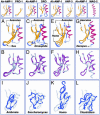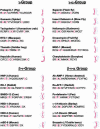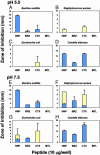Multidimensional signatures in antimicrobial peptides
- PMID: 15118082
- PMCID: PMC409924
- DOI: 10.1073/pnas.0401567101
Multidimensional signatures in antimicrobial peptides
Abstract
Conventional analyses distinguish between antimicrobial peptides by differences in amino acid sequence. Yet structural paradigms common to broader classes of these molecules have not been established. The current analyses examined the potential conservation of structural themes in antimicrobial peptides from evolutionarily diverse organisms. Using proteomics, an antimicrobial peptide signature was discovered to integrate stereospecific sequence patterns and a hallmark three-dimensional motif. This striking multidimensional signature is conserved among disulfide-containing antimicrobial peptides spanning biological kingdoms, and it transcends motifs previously limited to defined peptide subclasses. Experimental data validating this model enabled the identification of previously unrecognized antimicrobial activity in peptides of known identity. The multidimensional signature model provides a unifying structural theme in broad classes of antimicrobial peptides, will facilitate discovery of antimicrobial peptides as yet unknown, and offers insights into the evolution of molecular determinants in these and related host defense effector molecules.
Figures






Similar articles
-
Structural congruence among membrane-active host defense polypeptides of diverse phylogeny.Biochim Biophys Acta. 2006 Sep;1758(9):1373-86. doi: 10.1016/j.bbamem.2006.03.027. Epub 2006 Apr 19. Biochim Biophys Acta. 2006. PMID: 16725105
-
Structural correlates of antimicrobial efficacy in IL-8 and related human kinocidins.Biochim Biophys Acta. 2007 Mar;1768(3):598-608. doi: 10.1016/j.bbamem.2006.11.011. Epub 2006 Nov 30. Biochim Biophys Acta. 2007. PMID: 17208195
-
The gamma-core motif correlates with antimicrobial activity in cysteine-containing kaliocin-1 originating from transferrins.Biochim Biophys Acta. 2007 Nov;1768(11):2862-72. doi: 10.1016/j.bbamem.2007.07.024. Epub 2007 Aug 16. Biochim Biophys Acta. 2007. PMID: 17916323
-
Unifying themes in host defence effector polypeptides.Nat Rev Microbiol. 2007 Sep;5(9):727-40. doi: 10.1038/nrmicro1744. Nat Rev Microbiol. 2007. PMID: 17703227 Review.
-
Cysteine-rich antimicrobial peptides in invertebrates.Biopolymers. 1998;47(6):465-77. doi: 10.1002/(SICI)1097-0282(1998)47:6<465::AID-BIP5>3.0.CO;2-#. Biopolymers. 1998. PMID: 10333738 Review.
Cited by
-
Polyarginine Interacts More Strongly and Cooperatively than Polylysine with Phospholipid Bilayers.J Phys Chem B. 2016 Sep 8;120(35):9287-96. doi: 10.1021/acs.jpcb.6b05604. Epub 2016 Aug 29. J Phys Chem B. 2016. PMID: 27571288 Free PMC article.
-
Peptides Derived From the α-Core and γ-Core Regions of a Putative Silybum marianum Flower Defensin Show Antifungal Activity Against Fusarium graminearum.Front Microbiol. 2021 Feb 17;12:632008. doi: 10.3389/fmicb.2021.632008. eCollection 2021. Front Microbiol. 2021. PMID: 33679660 Free PMC article.
-
Antimicrobial mechanism of action of transferrins: selective inhibition of H+-ATPase.Antimicrob Agents Chemother. 2010 Oct;54(10):4335-42. doi: 10.1128/AAC.01620-09. Epub 2010 Jul 12. Antimicrob Agents Chemother. 2010. PMID: 20625147 Free PMC article.
-
Improved smallest peptides based on positive charge increase of the γ-core motif from PνD1 and their mechanism of action against Candida species.Int J Nanomedicine. 2019 Jan 9;14:407-420. doi: 10.2147/IJN.S187957. eCollection 2019. Int J Nanomedicine. 2019. PMID: 30666103 Free PMC article.
-
Transcriptomic Profile of Penicillium digitatum Reveals Novel Aspects of the Mode of Action of the Antifungal Protein AfpB.Microbiol Spectr. 2023 Jun 15;11(3):e0484622. doi: 10.1128/spectrum.04846-22. Epub 2023 Apr 6. Microbiol Spectr. 2023. PMID: 37022187 Free PMC article.
References
-
- Yeaman, M. R. & Yount, N. Y. (2003) Pharmacol. Rev. 55, 27-55. - PubMed
-
- Blaser, M. J. (2002) N. Engl. J. Med. 346, 2083-2085. - PubMed
-
- White, S. H., Wimley, W. C. & Selsted, M. E. (1995) Curr. Opin. Struct. Biol. 5, 521-527. - PubMed
-
- Guder, A., Wiedemann, I. & Sahl, H. G. (2000) Biopolymers 55, 62-73. - PubMed
Publication types
MeSH terms
Substances
Grants and funding
LinkOut - more resources
Full Text Sources
Other Literature Sources
Medical
Molecular Biology Databases

